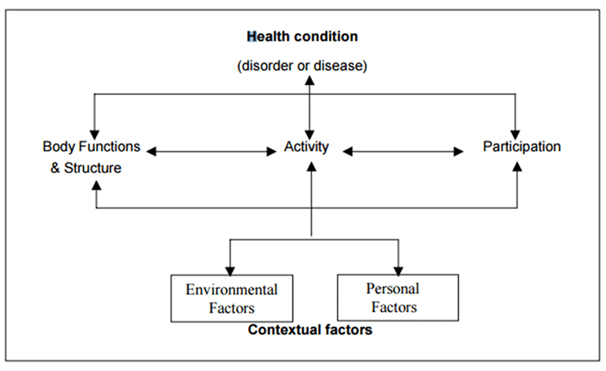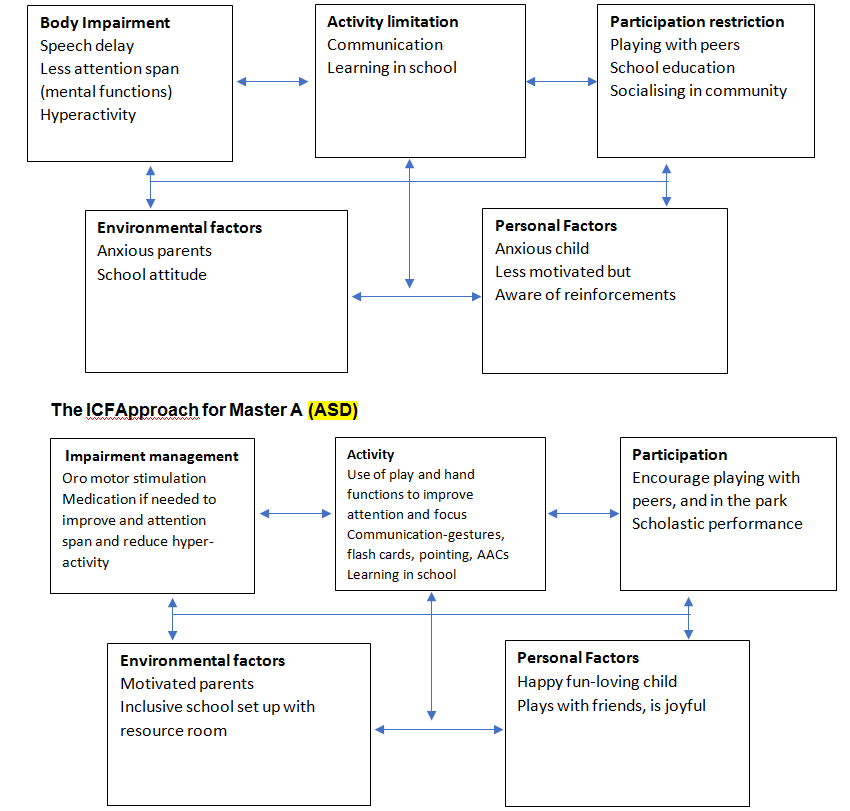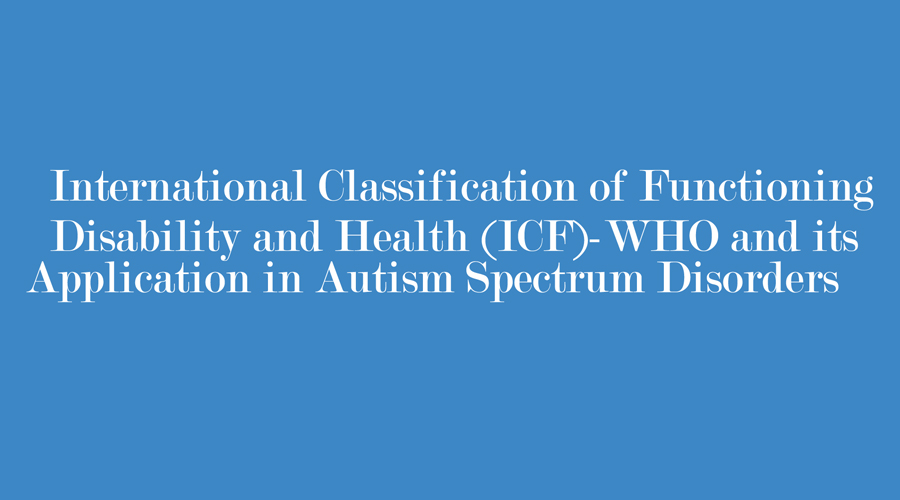International classification of functioning disability and health (ICF)- WHOAnd Its Application In Autism Spectrum Disorders
By: Puja Dhande
The international classification of functioning disability and health commonly called a ICF was devised by the World Health Organisation and adapted by all the WHO member states in the year in the year May 2001. ICF basically provides a common language of classification of health and health related domains for the health care professional worldwide. It helps us to understand what a person with a health condition can do in a standard environment (their level of capacity), as well as what they actually do in their usual environment (their level of performance) by understanding changes in the body functions and structure. ICF has marked a paradigm shift in the way disability and health are perceived and measured. Till now ‘health’ was seen and an absence of disease or opposite of death, whereas ‘disability’ on the other hand was looked up to as a medical issue, a bodily impairment that hinders a person’s day to day functioning. The ICF has brought together these two domains under an umbrella considering the biopsychosocial aspects of a person.ICF, thus, presents health and disability in a single spectrum.
Understanding ICF
The ICF systematically describes a person’s health condition in to two domains:
- Functioning, disability and its impact on participation level
- Contextual factors like personal factors and environmental factors
Till recent times we were more focussed on the ‘disability’ rather than the functioning. ICF focusses more on health and functioning rather than the disability. ICF clearly emphasises that there needs to be a shift in the attitude where disability is concerned. Instead of categorising a person disability, ICF focusses more on its impact on the person’s functioning in his social environment, no matter what the impairments are. ICF makes us understand that every human being can experience a certain health condition at any point in life and it is not restricted to a certain category of people. This is a universal human experience and thus ICF shifts our focus from ‘cause’ to ‘impact’. ICF focusses more on the strengths of an individuals, what the individual ‘can do’ rather than what he ‘cannot do’.
The ICF Model
The medical model views disability as a feature of the person, directly caused by disease, trauma or other health condition, which requires medical care provided in the form of individual treatment by professionals. Disability, on this model, calls for medical or other treatment or intervention, to ‘correct’ the problem with the individual.
The social model of disability, on the other hand, sees disability as a sociallycreated problem and not at all an attribute of an individual. On the social model, disability demands a political response, since the problem is created by an unaccommodating physical environment brought about by attitudes and other features of the social environment. (WHO)
ICF has created a model that integrates the above two models as disability is an interaction between the person’s health condition and in overall context in which the person lives (personal and environmental).

ICF Model
In the ICF, functioning and disability are multi-dimensional concepts, relating to:
- Body Functions are physiological functions of body systems (including psychological functions).
- Body Structures are anatomical parts of the body such as organs, limbs and their components.
- Impairments are problems in body function or structure such as a significant
- Activity is the execution of a task or action by an individual.
- Participation is involvement in a life situation.
- Activity Limitations are difficulties an individual may have in executing activities.
- Participation Restrictions are problems an individual may experience in involvement in life situations.
- Environmental Factors make up the physical, social and attitudinal environment in which people live and conduct their lives. (WHO)
ICF components and domains/chapters
| Body Function: Mental functions Sensory functions and pain Voice and speech functions Functions of the cardiovascular, haematological, immunological and respiratory systems Functions of the digestive, metabolic, endocrine systems Genitourinary and reproductive functions Neuromusculoskeletal and movement-related functionsFunctions of the skin and related structures | Activities and Participation: Learning and applying knowledge General tasks and demands Communication MobilitySelf careDomestic life Interpersonal interactions and relationships Major life areasCommunity, social and civic life |
| Body Structure: Structure of the nervous system The eye, ear and related structuresStructures involved in voice and speechStructure of the cardiovascular, immunological and respiratory Systems Structures related to the digestive, metabolic and endocrine systems Structure related to genitourinary and reproductive systems Structures related to movementSkin and related structures | Environmental Factors: Products and technologyNatural environment and human-made changes to environment Support and relationshipsAttitudes Services, systems and policies |
Source: WHO 2001: 29-30
Let’s try to understand it from an ASD case study point of view
- Master A is 3 years old male child of unrelated parents brought with a complaint of delayed speech and communication, lack of joint attention, hyperactive and less attention span and social skills delay.
- A was born full term, mother had gestational diabetes in the third trimester controlled with medication.She had stressful pregnancy.
- Mother is keen for a ‘cure’ so that the child becomes ‘normal’. She is working full time and the child stays with grandparents. He becomes anxious by the thought of going to school and is unable to make friends in school and his building. School teachers say he does not sit in one place and expects mother to shadow him.
- Development: A achieved his developmental milestones on time. However, he spoke first word at the age of 2yrs, now he speaks one word, communicates his needs by pulling parents’ hands towards desired object for eg: food, toy etc. he follows very simple commands, he cooperates in feeding, dressing and toilet activities, but needs assistance from mother/ grandparents, he scribbles on paper. He likes listening to music and water play.
- Neurologic examination: A has mild hypotonia, but able to run and jump. He has depressed tendon jerks. MRI normal
- All the above observations point to a high risk autism
What a traditional approach will do? (biological model)
- Try to determine the cause
- Refer the child to a neurologist, child psychiatrist, special school
- Refer the child to a speech therapist
ICF framework for integrating and compiling the clinical story

Take for example: In autism spectrum disorders (ASD) the major impact is on communication and social skills. Most parents will always look at the angle of ‘speech’ rather than focus on ‘communication’. Which means they will ultimately want the child to ‘utter words’ than communicate through pointing, gestures, cards etc. Speech development is a very complex phenomenon and can take many months or years to develop. A lot of time is wasted in making the child ‘speak’, when that time could have been utilised by using the alternative augmentative methods of communication (AACs). This builds up frustration in the child and the family as well. Whereas, ICF principles will focus more on improving the communication(function) through the use of various devices like flash cards, emotions cards, gestures, finger movements, sign language, pointing etc, enhancing the participation. Hence, while we are working on speech (body structure) it will always be better that alternative methods of communication (activity – function) are used.
How there is a shift in the approach after using ICF
- Focus shifts from ‘cause’ to ‘impact’.
- Focussing more on ‘what the child can do’ from ‘what the child cannot do’.
- More emphasis on participation
- ‘Optimising’ the function becomes more important rather than ‘normalising’
- Improvement in the functional ability of the child
- It encourages family centred approach
- Provides multiple points of entry for intervention
- Gives care givers a meaningful way of communication
Conclusion:
ICF offers a complete shift from a biological model to a biopsychosocial model of functioning. It is a universal scientific tool that can be used by persons with disability and health care professionals alike. It can be used for research purposes into disabilities in all the dimensions, impairment at the body part level, activity limitations, participation restrictions, personal and motivating factors and effect of environment on the participation.
ICF will be useful for persons with all forms of disabilities, not only for identifying their health care and rehabilitative needs, but also in identifying and measuring the effect of the physical and social environment on the disadvantages that they experience in their lives.
ICF helps to cross the attitudinal barrier in how disability is perceived. It brings the shift from ‘fixing’ and certain health condition to ‘optimising’ it.
ICF can be used most importantly as a planning and policy tool for decision-makers.
To sum up ICF will give a more meaningful picture of the patient’s health, which can be used for better management decisions.
References
- World Health Organization. International Classification of Functioning, Disability and Health (ICF) Geneva: World Health Organization; 2001.
- World Health Organization. International Classification of Impairments, Disabilities and Handicaps (ICIDH) Geneva: World Health Organization; 1980
- https://www.ncbi.nlm.nih.gov/pmc/articles/PMC3104216/
- www.canchild.ca


I am so grateful for your blog post. Thanks Again. Really Cool. Dre Dwight Archambault
Some genuinely nice stuff on this website , I love it. Sara-Ann Marten Pepper
Thanks
Wow, this article is good, my younger sister is analyzing these kinds of things, so I am going to inform her. Madelyn Sargent June
I believe you have observed some very interesting details, thank you for the post. Cristie Port Breech
Thanks
It is actually a great and helpful piece of info. I am glad that you simply shared this helpful info with us. Please stay us informed like this. Thank you for sharing. Gaye Dov Raddy
Thanks
I could not refrain from commenting. Perfectly written! Tally Kane Janis
Thanks
Hello there! I simply want to give you a huge thumbs up for the excellent info you have got here on this post. I will be coming back to your website for more soon. Tarah Cecilius Skutchan
Thanks
This is a sample comment. A wonderful serenity has taken possession of my entire soul, like these sweet mornings of spring which I enjoy with my whole heart. I am alone, and feel the charm of existence in this spot. Lilias Carney Erroll
Great
Best wishes
It helps me a lot on how to solve and what are the tips on how to answer questions. Gray Rogerio Gemoets
Thanks
Thanks
A wonderful article to be read by professionals working in the field of child development and Parents with special children.
This us also a timely reminder to policy makers and educators in the field to include ICF in the curriculum of various concerned specialities
Thank you Puja